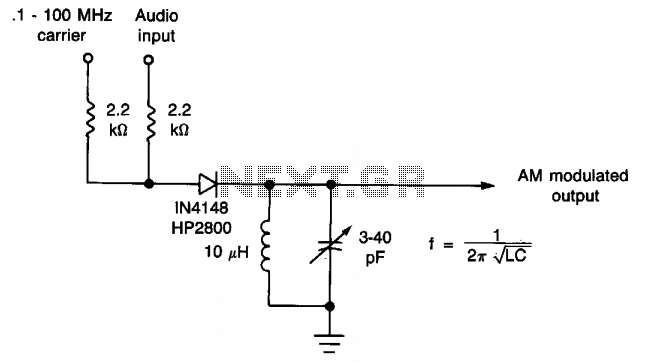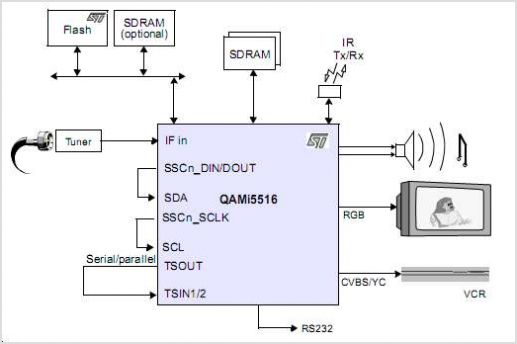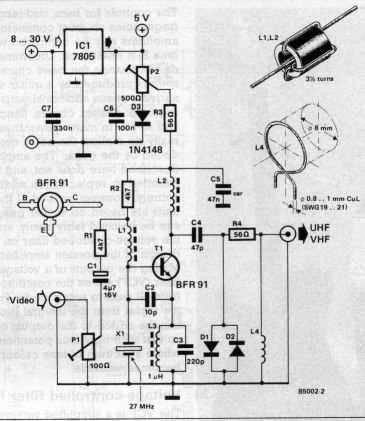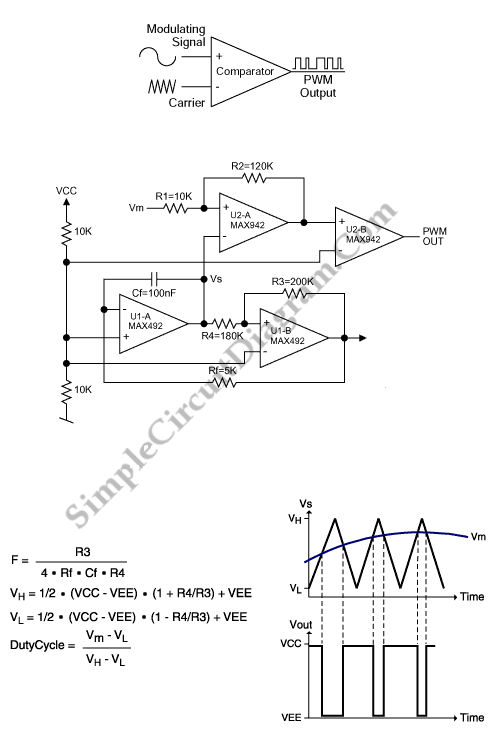
Rf modulator

Capacitors C1, C3, C5, and C6 should be dipped mica. C4 and C7 are compression or piston trimmer types. R6 is a PC-board mount trimpot. More: L1 is 6 turns of No. 14 enameled wire, with a 1-inch inner diameter and 0.5-inch long, tapped at 1 turn from the top.
The circuit design incorporates several critical components, including capacitors, resistors, and an inductor, each serving specific functions to ensure optimal performance. Capacitors C1, C3, C5, and C6 are specified as dipped mica types, known for their stability and low loss characteristics, making them suitable for applications requiring precision and reliability. The use of mica capacitors is particularly advantageous in high-frequency circuits due to their excellent temperature coefficient and low voltage coefficient.
Capacitors C4 and C7 are designated as compression or piston trimmer types, which allow for fine-tuning of capacitance values. This adjustability is vital in applications where precise tuning is necessary, such as in RF circuits or audio applications. The ability to adjust capacitance can help in achieving desired resonance frequencies or filtering characteristics.
Resistor R6 is identified as a PC-board mount trimpot, which facilitates easy adjustments to resistance values directly on the circuit board. This feature is particularly useful during the calibration phase of circuit development, enabling engineers to fine-tune the circuit's performance without needing to replace components.
The inductor L1 consists of 6 turns of No. 14 enameled wire, wound with a 1-inch inner diameter and a length of 0.5 inches. The design includes a tap at 1 turn from the top, which allows for additional flexibility in circuit design by enabling the selection of different inductance values or facilitating the implementation of a feedback loop. The choice of wire gauge and the number of turns are critical parameters that influence the inductor's inductance and resistance, thereby affecting the overall performance of the circuit.
In summary, the described components form a well-thought-out circuit design, emphasizing precision, adjustability, and flexibility, which are essential for achieving desired electrical characteristics in various applications.Capacitors Cl, C3, C5, and C6 should be dipped mica. C4 and C7 are compression or piston trimmer types. R6 is PC-board mount trimpot LI is 6 turns of No. 14 enameled wire, inch ID. by % inch long, tapped at 1 turn from top. 🔗 External reference
The circuit design incorporates several critical components, including capacitors, resistors, and an inductor, each serving specific functions to ensure optimal performance. Capacitors C1, C3, C5, and C6 are specified as dipped mica types, known for their stability and low loss characteristics, making them suitable for applications requiring precision and reliability. The use of mica capacitors is particularly advantageous in high-frequency circuits due to their excellent temperature coefficient and low voltage coefficient.
Capacitors C4 and C7 are designated as compression or piston trimmer types, which allow for fine-tuning of capacitance values. This adjustability is vital in applications where precise tuning is necessary, such as in RF circuits or audio applications. The ability to adjust capacitance can help in achieving desired resonance frequencies or filtering characteristics.
Resistor R6 is identified as a PC-board mount trimpot, which facilitates easy adjustments to resistance values directly on the circuit board. This feature is particularly useful during the calibration phase of circuit development, enabling engineers to fine-tune the circuit's performance without needing to replace components.
The inductor L1 consists of 6 turns of No. 14 enameled wire, wound with a 1-inch inner diameter and a length of 0.5 inches. The design includes a tap at 1 turn from the top, which allows for additional flexibility in circuit design by enabling the selection of different inductance values or facilitating the implementation of a feedback loop. The choice of wire gauge and the number of turns are critical parameters that influence the inductor's inductance and resistance, thereby affecting the overall performance of the circuit.
In summary, the described components form a well-thought-out circuit design, emphasizing precision, adjustability, and flexibility, which are essential for achieving desired electrical characteristics in various applications.Capacitors Cl, C3, C5, and C6 should be dipped mica. C4 and C7 are compression or piston trimmer types. R6 is PC-board mount trimpot LI is 6 turns of No. 14 enameled wire, inch ID. by % inch long, tapped at 1 turn from top. 🔗 External reference





